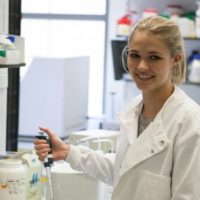graduated from the University of York in 2012 with a degree in Biochemistry. I have stayed in York for my PhD with Dr Daniela Barilla’. My project involves understanding the segregation mechanism of the multidrug resistant TP228 plasmid.
Low-copy number plasmids, implicated in antibiotic resistance, have evolved sophisticated strategies to ensure their faithful distribution at cell division. They harbour a partition cassette, which ensures an accurate segregation of the plasmids from one generation to the next. The multidrug resistance plasmid TP228 replicates at low copy number in Escherichia coli. Its partition cassette consists of the parFG genes and upstream noncoding sequence parH that harbours a series of direct and invert repeat motifs. We have shown that ParF is an ATPase assembling into multistranded filaments in vitro. The partner protein ParG binds to the parH site on the plasmid and plays at least two distinct roles in ParF polymerization: it enhances ParF ATPase activity and it promotes filament bundling. The ParF filaments are involved in moving and segregating the newly replicated plasmids before cell division. We have solved the structure of ParF, which allows an informed and detailed investigation of the polymerization mechanism of the protein. This project focuses on dissecting the assembly dynamics of ParF by analysing mutants impaired in this process exploiting approaches that surmount single discipline boundaries and range from genetics to chemistry, from biochemistry to biophysics and microscopy.

